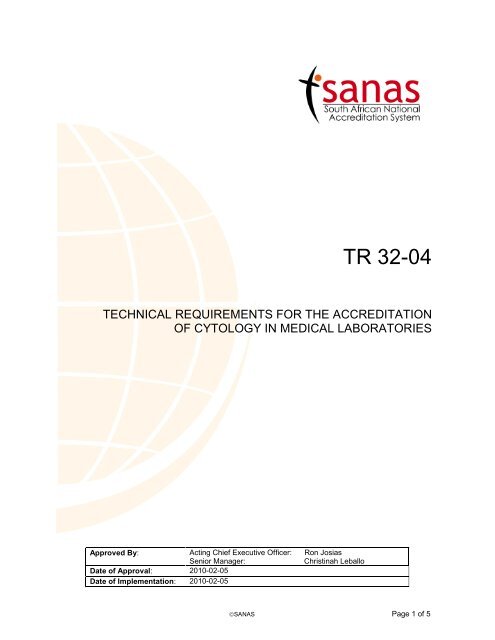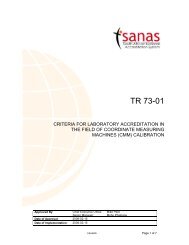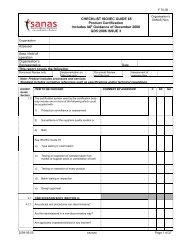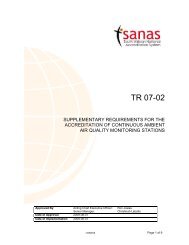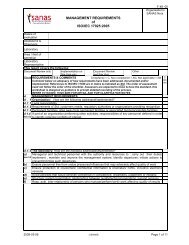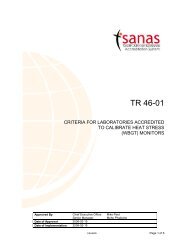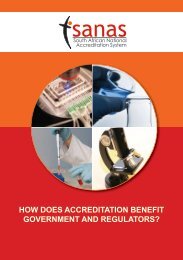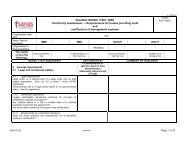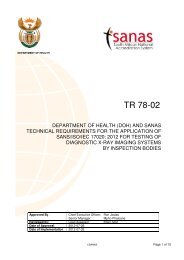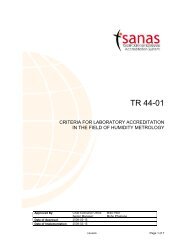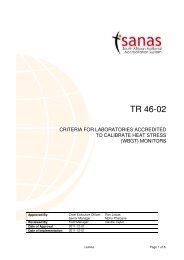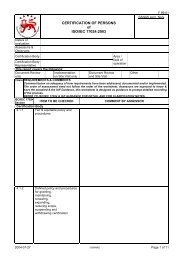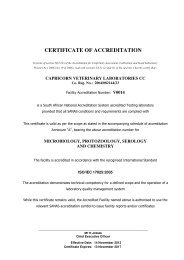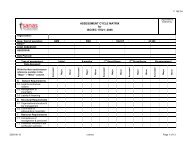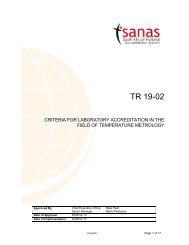TR 32-04 - Sanas
TR 32-04 - Sanas
TR 32-04 - Sanas
You also want an ePaper? Increase the reach of your titles
YUMPU automatically turns print PDFs into web optimized ePapers that Google loves.
<strong>TR</strong> <strong>32</strong>-<strong>04</strong><br />
TECHNICAL REQUIREMENTS FOR THE ACCREDITATION<br />
OF CYTOLOGY IN MEDICAL LABORATORIES<br />
Approved By: Acting Chief Executive Officer: Ron Josias<br />
Senior Manager:<br />
Christinah Leballo<br />
Date of Approval: 2010-02-05<br />
Date of Implementation: 2010-02-05<br />
©SANAS Page 1 of 5
<strong>TR</strong> <strong>32</strong>-<strong>04</strong><br />
CONTENTS:<br />
1. Purpose and Scope<br />
2. Definitions and References<br />
3. List of General Requirements<br />
3.1 Organisation and Management<br />
3.2 Quality and Technical Records<br />
3.3 Pre-Examination Procedures<br />
3.3.1 Sample Collection, Reception & Requisition Form<br />
3.4 Examination Procedures<br />
3.5 Assuring Quality of Examination Procedures<br />
3.6 Reporting of Results<br />
3.7 Laboratory Equipment<br />
3.8 Accommodation & Environmental Conditions and Laboratory Safety<br />
4. Authorship<br />
ADDENDUM 1: Amendment Record<br />
©SANAS Page 2 of 7
<strong>TR</strong> <strong>32</strong>-<strong>04</strong><br />
1. Purpose and Scope<br />
This document describes the managerial and technical accreditation requirements of a Cytology<br />
Laboratory. It applies to all Medical Laboratories requiring accreditation to ISO 15189 or ISO/IEC<br />
17025.<br />
2. Definitions and References<br />
SANAS PM<br />
SANAS A01<br />
ISO 15189<br />
ISO/IEC 17025:2005<br />
SANAS Policy Manual<br />
References, Acronyms and Definitions<br />
Medical Laboratories – Particular requirements for quality and competence<br />
General Requirements for the Competence of Testing and Calibration<br />
Laboratories<br />
3. List of General Requirements<br />
All assessments are done in accordance with the relevant ISO or ISO/IEC Standards and SANAS<br />
requirements. SANAS documents are available on the SANAS website at www.sanas.co.za.<br />
3.1 Organisation and Management<br />
3.1.1 All professional staff shall comply fully with the HPCSA Act and regulations applicable<br />
to their professions.<br />
3.1.2 Screening of cytology samples shall only be performed at the following sites:<br />
3.1.2.1 Medical laboratory premises:<br />
a) The above sites shall have fixed premises and an identifiable address;<br />
b) The sites at which cytology samples may be screened shall meet all the<br />
requirements as stated in the SANAS Generic Checklist and any other<br />
statutory requirements.<br />
3.1.2.2 Approved stat service sites, e.g. theatre, clinics<br />
3.2 Quality and Technical Records<br />
3.2.1 The laboratory shall maintain statistics of the number of samples handled in the<br />
laboratory classified under the following headings:<br />
3.2.1.1 Gynaecological;<br />
3.2.1.2 General (non-gynaecological) cytology;<br />
3.2.1.3 Fine needle aspirations.<br />
3.2.2 Cytology slides shall be retained for the periods indicated below:<br />
3.2.2.1 Gynaecological slides: Minimum of 10 years;<br />
3.2.2.2 Non-malignant non-gynaecologic slides: Minimum of 10 years;<br />
3.2.2.3 All abnormal slides: An indefinite period Minimum of 10 years.<br />
3.2.3. Original request forms and final reports shall be retained for a minimum of 10 years.<br />
3.2.4. If any relevant records or slides are removed from a file, this shall be clearly marked<br />
with a rider stating the current location of such records / slides and the person<br />
responsible for their safe custody and return to the file.<br />
©SANAS Page 3 of 7
<strong>TR</strong> <strong>32</strong>-<strong>04</strong><br />
3.3 Pre-Examination Procedures<br />
3.3.1. Sample Collection, Reception & Requisition Form<br />
3.3.1.1 The sampling procedures, describing the sampling requirements for each<br />
sample, shall be readily available for all submitting locations (e.g. clinics,<br />
hospitals) and shall contain the following information:<br />
i) Preparation of patient for sampling;<br />
ii) Collection techniques;<br />
iii) Specimen identification and labelling;<br />
iv) Fixation requirements: e.g. fresh, anticoagulants, fixatives and storage<br />
requirements;<br />
v) Transportation instructions;<br />
vi) Safety precautions for all of the above.<br />
3.3.1.2 Where possible, FNAB sampling shall be carried out by a pathologist. In the<br />
absence of a pathologist, a clinician that has been trained or follows the<br />
documented procedure as provided by the laboratory may perform FNAB<br />
sampling.<br />
3.3.1.3 A completed Cytology requisition form must accompany every specimen and<br />
shall include the following information:<br />
3.4 Examination Procedures<br />
i) Full demographic data;<br />
ii) Relevant clinical history;<br />
iii) Current clinical findings;<br />
iv) Anatomical site of specimen and collection method;<br />
v) Requesting clinician’s details;<br />
vi) Date of specimen collection.<br />
In addition, gynaecological cases shall also contain:<br />
vii) Menstrual phase and hormonal status<br />
viii) Details of hormonal therapy<br />
ix) Details of contraception<br />
3.4.1 A procedure manual on slide and specimen reception shall be available and shall<br />
include:<br />
3.4.1.1 Allocation of accession / laboratory numbers;<br />
3.4.1.2 This accession / laboratory number shall appear on all:<br />
a) glass slides (written with a diamond pencil, or on frosted-end slides with a<br />
HB pencil)<br />
b) requisition forms<br />
c) specimen containers<br />
3.4.1.3 Date and time of receipt;<br />
3.4.1.4 Specimen condition i.e. macroscopic appearance, quantity, fixed or not, etc.;<br />
3.4.1.5 Specimen rejection criteria and protocols e.g. improper documentation,<br />
improper specimen etc.;<br />
3.4.1.6 Safety precautions.<br />
3.4.2 A cytopreparatory procedure manual shall be available defining separately the<br />
techniques for Gynaecological and the individual non-gynaecological specimens taking<br />
into account the following:<br />
3.4.2.1 All safety precautions;<br />
3.4.2.2 specimen concentration techniques;<br />
3.4.2.3 slide preparations;<br />
3.4.2.4 fixatives;<br />
3.4.2.5 solutions;<br />
3.4.2.6 staining and mounting;<br />
©SANAS Page 4 of 7
<strong>TR</strong> <strong>32</strong>-<strong>04</strong><br />
3.2.4.7 storage of slides.<br />
3.2.5 To prevent cross contamination of material between slides, separate staining sets shall<br />
be used for Gynaecological and non-gynaecological slides. (In laboratories with low<br />
volumes of slides, staining solutions shall be filtered between the Gynaecological slides<br />
and the non-gynaecological slides being stained.) All working solutions should be<br />
changed frequently or filtered daily, solutions should be covered when not in use, etc.<br />
3.5 Assuring Quality of Examination Procedures<br />
3.5.1 The daily laboratory Quality Control policies and procedures shall address the<br />
following additional issues and ensure that QC records can be traced to the source e.g.<br />
documents or slides via accession / laboratory number etc.:<br />
3.5.1.1 Screening current work;<br />
3.5.1.2 Checking / reviewing of routine smears by either “Rapid Review” method or<br />
“10% Re-screen” method;<br />
3.5.1.3 Re-screening previous abnormal slides on receiving a subsequent smear<br />
from the same individual;<br />
3.5.1.4 Re-screening previous normal slides when a subsequent smear received<br />
from the same patient shows any evidence of abnormality;<br />
3.5.1.5 Cytopreparatory procedures, including staining quality and preparation;<br />
3.5.1.6 Administrative procedures involved in the screening process.<br />
3.5.2 Comply with National and/or International QA standards.<br />
3.5.3 Workload volumes for each screener shall be recorded.<br />
3.6 Reporting of Results<br />
3.5.3.1 The laboratory shall enforce workload limits for screeners.<br />
3.5.3.2 Follow up procedures and follow up records shall comply with the following<br />
requirements:<br />
a) Previously reported abnormal smears shall be matched with histological<br />
sections submitted for examination from the patient;<br />
b) For all abnormal smears the laboratory shall seek information regarding<br />
results of Coloscopy, biopsy and details of any treatment;<br />
c) The laboratory shall have procedures in place to follow up discrepancies<br />
identified between the biopsy results and cytological prediction;<br />
d) The laboratory shall implement a system to ensure that a list, of women<br />
notified to the cancer registry of the state as having invasive cervical<br />
cancer, is maintained and updated regularly;<br />
e) The ASCUS : SIL ratio shall comply with the latest Bethesda<br />
Recommendations.<br />
3.6.1 The terminology used in reporting shall be standardised and consistent.<br />
3.6.2 A pathologist or cytotechnologist in compliance with the HPCSA regulations shall report<br />
on all cases with significant abnormalities.<br />
3.6.3 Explanatory notes shall accompany any unsatisfactory or equivocal report.<br />
3.6.4 All routine work should be completed and reported within 5 working days.<br />
3.6.5 All malignancies or suspected malignancies shall be reported immediately in writing. A<br />
telephonic report shall be followed by a written report as soon as possible<br />
3.6.6 All reports with abnormal findings shall make recommendations regarding further<br />
clinical / cytological investigations.<br />
©SANAS Page 5 of 7
<strong>TR</strong> <strong>32</strong>-<strong>04</strong><br />
3.7 Laboratory Equipment<br />
3.7.1 All equipment shall have operating manuals, maintenance records, etc.<br />
3.7.2 Microscopes used for screening shall have 10 X and 40 X objectives.<br />
3.7.3 Spare bulbs and fuses shall be available in the laboratory.<br />
3.7.4 All equipment such as centrifuges, homogenizers etc., capable of creating biohazardous<br />
aerosols shall be used in extractor cabinets or rooms fitted with extractor<br />
facilities.<br />
3.8 Accommodation & Environmental Conditions, and Laboratory Safety<br />
4. Authorship<br />
3.8.1 All laboratory staff shall observe and adhered to the Occupational Health and Safety,<br />
and other relevant, Acts and regulations relating to the hazards of chemicals, reagents,<br />
ultraviolet light, electricity etc. as well as the biohazards involved with specimen<br />
handling and preparation.<br />
3.8.1.1 Appropriate protective measures shall be taken for handling, storage and<br />
spills.<br />
3.8.1.2 Material safety data sheets (MSDS) shall be available in the laboratory.<br />
3.8.2 The handling and preparation of wet preparations shall take place in biological safety<br />
cabinets or a room/cabinet with an effective fume extraction system.<br />
3.8.3 Mounting of slides should be performed under fume extraction.<br />
3.8.4 All chemicals and reagents in use or storage shall be labelled as follows:<br />
3.8.4.1 Name and type of chemical/reagent/solution;<br />
3.8.4.2 Expiry date;<br />
3.8.4.3 Date of receipt;<br />
3.8.4.4 Condition on receipt;<br />
3.8.4.5 Date placed in use;<br />
3.8.4.6 Date of preparation (where applicable) and initials of person preparing the<br />
solution.<br />
3.8.5 Appropriate procedures for the disposal of bio-hazardous and chemical waste shall be<br />
documented and followed.<br />
3.8.6 All accidents and incidents, as well as steps taken to prevent the reoccurrence, shall be<br />
documented.<br />
3.8.7 Adequate physical facilities shall be provided to enable all laboratory procedures to be<br />
performed safely and competently.<br />
3.8.8 Cytology screening areas shall be free of distractions and noise that can affect the<br />
concentration of the staff.<br />
This Technical Requirement document has been prepared and revised by the Medical Specialist<br />
Technical Committee members.<br />
SANAS is indebted to the contribution made by the committee members in the preparation of this<br />
document.<br />
©SANAS Page 6 of 7
<strong>TR</strong> <strong>32</strong>-<strong>04</strong><br />
ADDENDUM 1.<br />
AMENDMENT RECORD<br />
Proposed By: Section Change<br />
SM All Changed from a technical guidance (TG <strong>32</strong>) back to a technical<br />
requirement document (<strong>TR</strong> <strong>32</strong>)<br />
STC Section 1 Deleted: “and shall be used in conjunction with the requirements listed in<br />
the ISO 15189 Standard. For ISO/IEC 17025:2005 clauses, refer to the<br />
equivalent sections in the standard” and “SANAS accredited”<br />
Added: “requiring accreditation to ISO 15189 or ISO/IEC 17025”<br />
Section 3 Deleted: “Additional copies of SANAS documentation may be purchased<br />
from the office.”<br />
Section 3.1 Deleted:<br />
(Clause 4.1)<br />
Should replaced by shall<br />
Section 3.2 Deleted: (Clause 4.13)<br />
Section 3.3 Deleted: (Clause 5.4)<br />
Section 3.4 Deleted: (Clause 5.5)<br />
Section 3.5 Deleted: (Clause 5.6)<br />
Section 3.6 Deleted: (Clause 5.8)<br />
Should replaced by shall<br />
Section 3.7 Deleted: (Clause 5.3)<br />
Section 3.8 Deleted: (Clause 5.2)<br />
©SANAS Page 7 of 7


